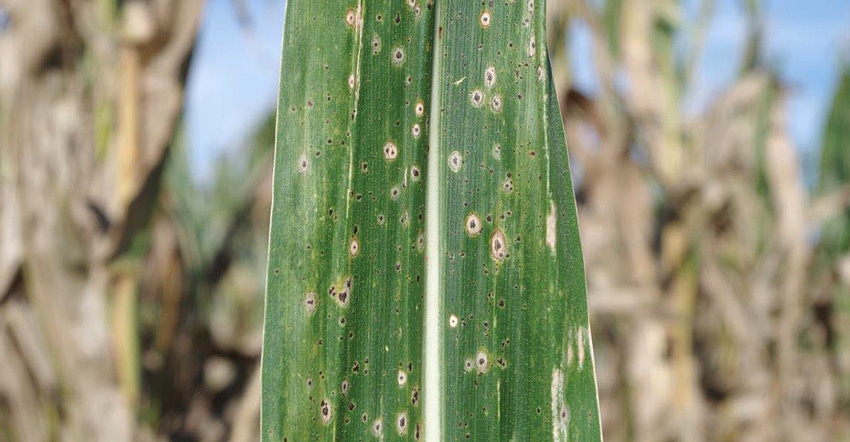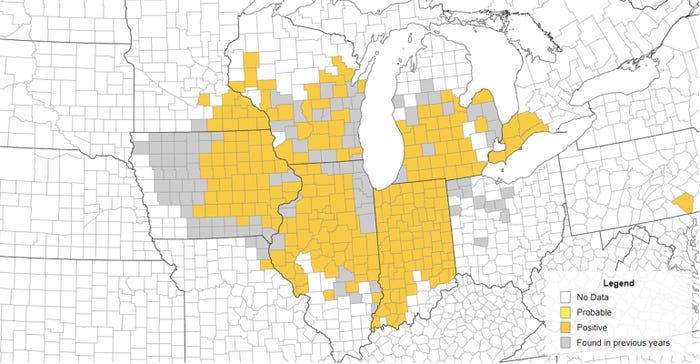
Corn tar spot, first identified in Minnesota in 2019 in four counties, was confirmed in 2020 in 11 counties in southeastern Minnesota, including one county west of Interstate 35.
The fungal disease’s spread was no surprise to Dean Malvick, University of Minnesota Extension plant pathologist.
“These results confirm what we suspected — that tar spot would continue to spread in Minnesota,” Malvick says. “These confirmed counties only represent where tar spot was found and do not reflect how much further north or west it may have spread undetected.”
The university tested around 50 to 60 samples for tar spot in 2020. Dry weather in parts of southern Minnesota in July and August likely suppressed tar spot development and spread in 2020, Malvick adds.
“Most of the counties with tar spot had many different fields confirmed with this disease,” he says. “Fortunately, all or most of the confirmed tar spot developed only to low levels, or late enough such that yield loss was none or minimal.”
Scientists do know that corn tar spot is caused by the fungus Phyllachora maydis. It infects leaves and husks, and produces small raised black structures on leaf surfaces. The black structures are firm and smooth and do not rub off or break open, as do rust pustules.
Tar spot can result in significant corn yield loss, depending on weather, severity and timing of disease development. Yield loss due to tar spot has not yet been confirmed in Minnesota.
 EXPECTED SPREAD: Corn tar spot spread to 11 Minnesota counties in 2020, up from four the previous growing season.
EXPECTED SPREAD: Corn tar spot spread to 11 Minnesota counties in 2020, up from four the previous growing season.

If tar spot develops to high levels before maturity, fungicides can be used to manage it. However, optimal application timing needs to be determined. Proactive scouting can guide potential need and timing for fungicide applications. Risk of this disease is highest where the disease has occurred previously.
Malvick notes that the last sample received in fall 2020 with suspected tar spot symptoms turned out to be the black lesions that are common with mature rust infection. Common rust is common on corn across Minnesota, especially late in the season, Malvick says, and does not appear to be increasing overall. Southern rust infection is becoming more common, too, he adds.
When asked about tar spot prevalence in corn-on-corn and with cover crop practices, Malvick notes that corn-on-corn and corn residue seem to slightly increase the prevalence of tar spot. However, he also has seen tar spot in southeast Minnesota fields that were in soybeans the previous year.
“We need more information on the importance of pathogen inoculum from within a field [e.g., on residue] versus spread of the pathogen from nearby fields,” he says.
Regarding cover crops harboring the fungus, Malvick says that probability would be minimal, if at all.
“The tar spot pathogen is thought to primarily infect corn, although it is still unknown if any other grasses or cover crops can host the pathogen,” he says.
Crop rotation may help but it does not eliminate infection and tar spot development, he adds.
“We have a lot to learn about tar spot of corn and how far it may spread, and if it will become a sporadic, important problem in Minnesota,” Malvick says.
Multistate research efforts
Tar spot was first detected in the U.S. in 2015 and has quickly spread through the Corn Belt. In 2020, tar spot was confirmed in Ontario, Canada, and in Pennsylvania. Scientists predict that tar spot could soon reach as far west as parts of North Dakota and east to New York, further devastating yields. Even a 1% reduction in total domestic corn production could cost American farmers an estimated $231 billion in lost revenue, according to the Foundation for Food & Agricultural Research (FFAR). The disease has caused yield reductions by as much as 60 bushels per acre.
FFAR recently announced a $150,000 grant that will support research conducted by a group of plant pathologists to study and mitigate tar spot in corn. The challenge, however, starts with developing ways to study the disease. The fungus has been difficult to grow in the laboratory. Plus, little is known about the biology of tar spot, which is required to develop effective management practices.
The team of plant pathologists is in the process of mapping where the fungus is present, assessing the potential origins of the fungus and potential alternate hosts, understanding resistance in corn germplasm, assessing tar spot management options such as resistant hybrids and fungicides, and developing outreach and Extension materials for corn farmers. The researchers are also building forecasting models to help producers make timely fungicide decisions using a free smartphone application. By working with corn farmers to collect information, this research will provide immediate benefits for producers, according to FFAR.
Participating in the multistate team are researchers from the University of Illinois, Iowa State University, Purdue University, Michigan State University, Ohio State University and the University of Wisconsin-Madison.
The grant was matched by the National Corn Growers Association, Corteva Agriscience, Wyffels Hybrids, the Illinois Corn Growers Association and Purdue University, for a total investment of $300,000.
To learn more about tar spot in corn, visit Tar Spot of Corn | Crop Protection Network.
To view a map showing the spread of the fungal disease, visit Tar Spot - Corn ipmPIPE.
About the Author(s)
You May Also Like






